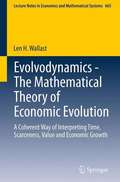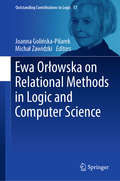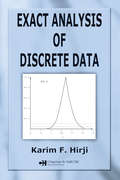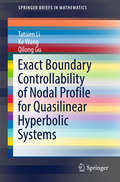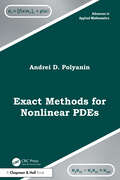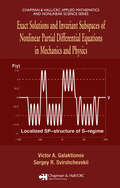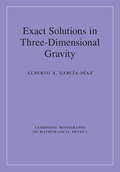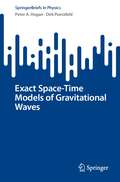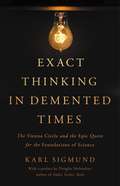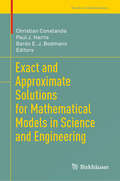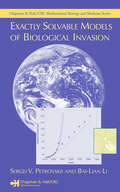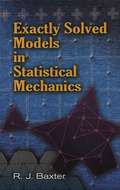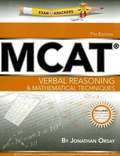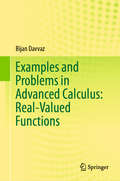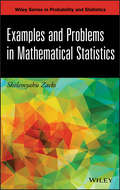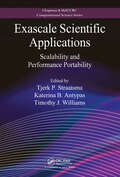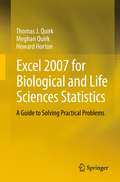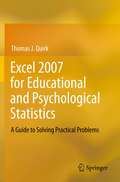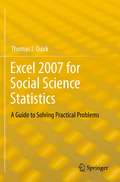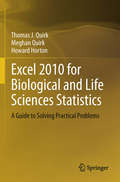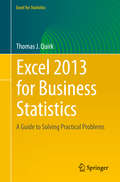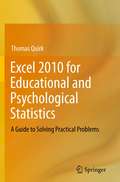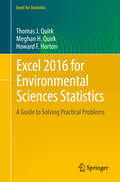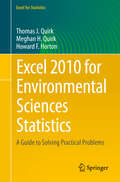- Table View
- List View
Evolvodynamics - The Mathematical Theory of Economic Evolution
by Len H. WallastDissatisfied with the flaws of orthodox economics, the author proposes to base economic theory on the three principles of Darwinian evolution (variation, inheritance, selection). Pursuing a suggestion of E.T. Jaynes of 1991, the innovation is in treating economic behavior as chance events of selection. This involves abandoning the methods of mainstream economics and to apply instead the methods by which Claude E. Shannon analyzed information transport over a stationary channel. As economic processes are non-stationary, the author clarifies first how the Shannon-system must be reshaped in a system capable to describe economic evolution mathematically. As economic processes are non-stationary, the author first clarifies how the Shannon system must be reshaped into one capable of describing economic evolutions mathematically. Deriving the universal relations between input, output, the economic growth rate, inflation and money flow involves applying differential sets of selection, Venn diagrams, bitpulses as units of selection and the probability distributions of bitpulses. This is a thought-provocative and highly informative book of which the explanatory power goes far beyond that of traditional economics. It should be on the readers list of everyone concerned with the weal and woe of economic theorizing.
Ewa Orłowska on Relational Methods in Logic and Computer Science (Outstanding Contributions to Logic #17)
by Joanna Golińska-Pilarek Michał ZawidzkiThis book is a tribute to Professor Ewa Orłowska, a Polish logician who was celebrating the 60th year of her scientific career in 2017. It offers a collection of contributed papers by different authors and covers the most important areas of her research. Prof. Orłowska made significant contributions to many fields of logic, such as proof theory, algebraic methods in logic and knowledge representation, and her work has been published in 3 monographs and over 100 articles in internationally acclaimed journals and conference proceedings. The book also includes Prof. Orłowska’s autobiography, bibliography and a trialogue between her and the editors of the volume, as well as contributors' biographical notes, and is suitable for scholars and students of logic who are interested in understanding more about Prof. Orłowska’s work.
Exact Analysis of Discrete Data
by Karim F. HirjiResearchers in fields ranging from biology and medicine to the social sciences, law, and economics regularly encounter variables that are discrete or categorical in nature. While there is no dearth of books on the analysis and interpretation of such data, these generally focus on large sample methods. When sample sizes are not large or the data are
Exact Boundary Controllability of Nodal Profile for Quasilinear Hyperbolic Systems
by Tatsien Li Ke Wang Qilong GuThis book provides a comprehensive overview of the exact boundary controllability of nodal profile, a new kind of exact boundary controllability stimulated by some practical applications. This kind of controllability is useful in practice as it does not require any precisely given final state to be attained at a suitable time t=T by means of boundary controls, instead it requires the state to exactly fit any given demand (profile) on one or more nodes after a suitable time t=T by means of boundary controls. In this book we present a general discussion of this kind of controllability for general 1-D first order quasilinear hyperbolic systems and for general 1-D quasilinear wave equations on an interval as well as on a tree-like network using a modular-structure construtive method, suggested in LI Tatsien's monograph "Controllability and Observability for Quasilinear Hyperbolic Systems"(2010), and we establish a complete theory on the local exact boundary controllability of nodal profile for 1-D quasilinear hyperbolic systems.
Exact Controllability and Stabilization of the Wave Equation (UNITEXT #162)
by Enrique ZuazuaThis comprehensive monograph illustrates the intricate realm of controllability and stabilization of wave phenomena. Authored by an expert in the field, this book integrates J. L. Lion's renowned HUM method, multiplier techniques, and the construction of Lyapunov functionals. Through meticulous analysis and practical applications, this book provides invaluable insights for researchers seeking to navigate the expansive domain of wave-like equations and their control. Whether you are a seasoned mathematician or a newcomer to the field, this book serves as an indispensable guide, offering a thorough introduction and essential tools for understanding and controlling wave phenomena.
Exact Methods for Nonlinear PDEs (Advances in Applied Mathematics)
by Andrei D. PolyaninExact Methods for Nonlinear PDEs describes effective analytical methods for finding exact solutions to nonlinear differential equations of mathematical physics and other partial differential equations and also demonstrates the practical applications of these methods. It covers the methods of generalized separation of variables, methods of functional separation of variables, the classical method of symmetry reductions, the direct method of symmetry reductions, the method of weak symmetry reductions, and the method of differential constraints. The book presents several simple methods for finding exact solutions to nonlinear partial differential equations (PDEs). These methods do not require specialized knowledge and aim to minimize intermediate calculations. For the first time, it discusses the application of nonrigorous, intuitive reasoning in deriving exact solutions to nonlinear PDEs.Each section provides numerous examples, problems, and exercises to help readers develop practical skills in applying the methods. The material is illustrated with equations of mass and heat transfer, hydrodynamics, wave theory, nonlinear optics, and other nonlinear equations of mathematical physics. The key points that distinguish this book from others in the field include: • it presents many methods in a simpler and more visual format; • it describes a number of simple methods for constructing exact solutions to nonlinear PDEs and delay PDEs;• it emphasizes and details the practical use of non-rigorous reasoning to derive exact solutions for nonlinear PDEs. The book is intended for a diverse audience, including researchers, university professors, engineers, postgraduates, and students specializing in applied mathematics, theoretical physics, and engineering sciences.
Exact Solutions and Invariant Subspaces of Nonlinear Partial Differential Equations in Mechanics and Physics
by Victor A. Galaktionov Sergey R. SvirshchevskiiExact Solutions and Invariant Subspaces of Nonlinear Partial Differential Equations in Mechanics and Physics is the first book to provide a systematic construction of exact solutions via linear invariant subspaces for nonlinear differential operators. Acting as a guide to nonlinear evolution equations and models from physics and mechanics, the book
Exact Solutions in Three-Dimensional Gravity (Cambridge Monographs on Mathematical Physics)
by Alberto A. García-DíazA self-contained text, systematically presenting the determination and classification of exact solutions in three-dimensional Einstein gravity. This book explores the theoretical framework and general physical and geometrical characteristics of each class of solutions, and includes information on the researchers responsible for their discovery. Beginning with the physical character of the solutions, these are identified and ordered on the basis of their geometrical invariant properties, symmetries, and algebraic classifications, or from the standpoint of their physical nature, for example electrodynamic fields, fluid, scalar field, or dilaton. Consequently, this text serves as a thorough catalogue on 2+1 exact solutions to the Einstein equations coupled to matter and fields, and on vacuum solutions of topologically massive gravity with a cosmological constant. The solutions are also examined from different perspectives, enabling a conceptual bridge between exact solutions of three- and four-dimensional gravities, and therefore providing graduates and researchers with an invaluable resource on this important topic in gravitational physics. The first book in the field of 2+1 gravity to examine solutions of physical interest. All the physical and mathematical concepts required are explained in the text, enabling readers to gain a complete understanding of the complexities of the field. Includes a complete review of vacuum solutions of topologically massive gravity with a cosmological constant, which shows the algebraic classification of space times at work.
Exact Space-Time Models of Gravitational Waves (SpringerBriefs in Physics)
by Dirk Puetzfeld Peter A. HoganThe book is about exact space-time models of the gravitational fields produced by gravitational radiation. The authors’ extensive work in the field is reviewed in order to stimulate the study of such models, that have been known for a long time, and to highlight interesting physical aspects of the existing models in some novel detail. There is an underlying simplicity to the gravitational radiation studied in this book. Apart from the basic assumption that the radiation has clearly identifiable wave fronts, the gravitational waves studied are directly analogous to electromagnetic waves. The book is meant for advanced students and researchers who have a knowledge of general relativity sufficient to carry out research in the field.
Exact Thinking in Demented Times: The Vienna Circle and the Epic Quest for the Foundations of Science
by Douglas Hofstadter Karl SigmundA dazzling group biography of the early twentieth-century thinkers who transformed the way the world thought about math and scienceInspired by Albert Einstein's theory of relativity and Bertrand Russell and David Hilbert's pursuit of the fundamental rules of mathematics, some of the most brilliant minds of the generation came together in post-World War I Vienna to present the latest theories in mathematics, science, and philosophy and to build a strong foundation for scientific investigation. Composed of such luminaries as Kurt Gödel and Rudolf Carnap, and stimulated by the works of Ludwig Wittgenstein and Karl Popper, the Vienna Circle left an indelible mark on science.Exact Thinking in Demented Times tells the often outrageous, sometimes tragic, and never boring stories of the men who transformed scientific thought. A revealing work of history, this landmark book pays tribute to those who dared to reinvent knowledge from the ground up.
Exact and Approximate Solutions for Mathematical Models in Science and Engineering (Trends in Mathematics)
by Christian Constanda Paul J. Harris Bardo E. J. BodmannThis contributed volume collects papers presented during a special session on integral methods in science and engineering at the 2023 International Conference on Computational and Mathematical Methods in Science and Engineering (CMMSE), held in Cadiz, Spain from July 3-8, 2023. Covering the applications of integral methods to scientific developments in a variety of fields, the chapters in this volume are written by well-known researchers in their respective disciplines and present new results in both pure and applied mathematics. Each chapter shares a common methodology based on a combination of analytic and computational tools, an approach that makes this collection a valuable, multidisciplinary reference on how mathematics can be applied to various real-world processes and phenomena.
Exactly Solvable Models of Biological Invasion (Chapman & Hall/CRC Mathematical Biology Series)
by Sergei V. Petrovskii Bai-Lian LiMuch of our current knowledge on biological invasion was derived from field studies, but many recent advances relied heavily on mathematics and computing, particularly mathematical modeling. While numerical simulations are clearly a useful approach, they have some serious drawbacks. Approximations errors and the number of parameter values can have
Exactly Solved Models in Statistical Mechanics
by Rodney J. BaxterThis text explores the solution of two-dimensional lattice models. Topics include basic statistical mechanics, Ising models, the mean field model, the spherical model, ice-type models, corner transfer matrices, hard hexagonal models, and elliptic functions. The author has updated the 1989 version with a new chapter, "Subsequent Developments," for the 2007 edition.
Examkrackers MCAT Verbal Reasoning & Mathematical Techniques
by Jonathan OrsayA collection of review books with clear and concise explanations of all science concepts and formulas tested by the MCAT including practice passages and questions.
Examples and Problems in Advanced Calculus: Real-Valued Functions
by Bijan DavvazThis book includes over 500 most challenging exercises and problems in calculus. Topical problems and exercises are discussed on set theory, numbers, functions, limits and continuity, derivative, integral calculus, Rolle’s theorem, mean value theorem, optimization problems, sequences and series. All the seven chapters recall important definitions, theorems and concepts, making this book immensely valuable to undergraduate students of engineering, mathematics, statistics, computer science and basic sciences.
Examples and Problems in Mathematical Statistics
by Shelemyahu ZacksProvides the necessary skills to solve problems in mathematical statistics through theory, concrete examples, and exercisesWith a clear and detailed approach to the fundamentals of statistical theory, Examples and Problems in Mathematical Statistics uniquely bridges the gap between theory andapplication and presents numerous problem-solving examples that illustrate the relatednotations and proven results.Written by an established authority in probability and mathematical statistics, each chapter begins with a theoretical presentation to introduce both the topic and the important results in an effort to aid in overall comprehension. Examples are then provided, followed by problems, and finally, solutions to some of the earlier problems. In addition, Examples and Problems in Mathematical Statistics features:Over 160 practical and interesting real-world examples from a variety of fields including engineering, mathematics, and statistics to help readers become proficient in theoretical problem solvingMore than 430 unique exercises with select solutionsKey statistical inference topics, such as probability theory, statistical distributions, sufficient statistics, information in samples, testing statistical hypotheses, statistical estimation, confidence and tolerance intervals, large sample theory, and Bayesian analysisRecommended for graduate-level courses in probability and statistical inference, Examples and Problems in Mathematical Statistics is also an ideal reference for applied statisticians and researchers.
Exascale Scientific Applications: Scalability and Performance Portability (Chapman & Hall/CRC Computational Science)
by Timothy J. Williams Tjerk P. Straatsma Katerina B. AntypasFrom the Foreword: "The authors of the chapters in this book are the pioneers who will explore the exascale frontier. The path forward will not be easy... These authors, along with their colleagues who will produce these powerful computer systems will, with dedication and determination, overcome the scalability problem, discover the new algorithms needed to achieve exascale performance for the broad range of applications that they represent, and create the new tools needed to support the development of scalable and portable science and engineering applications. Although the focus is on exascale computers, the benefits will permeate all of science and engineering because the technologies developed for the exascale computers of tomorrow will also power the petascale servers and terascale workstations of tomorrow. These affordable computing capabilities will empower scientists and engineers everywhere."— Thom H. Dunning, Jr., Pacific Northwest National Laboratory and University of Washington, Seattle, Washington, USA "This comprehensive summary of applications targeting Exascale at the three DoE labs is a must read."— Rio Yokota, Tokyo Institute of Technology, Tokyo, Japan "Numerical simulation is now a need in many fields of science, technology, and industry. The complexity of the simulated systems coupled with the massive use of data makes HPC essential to move towards predictive simulations. Advances in computer architecture have so far permitted scientific advances, but at the cost of continually adapting algorithms and applications. The next technological breakthroughs force us to rethink the applications by taking energy consumption into account. These profound modifications require not only anticipation and sharing but also a paradigm shift in application design to ensure the sustainability of developments by guaranteeing a certain independence of the applications to the profound modifications of the architectures: it is the passage from optimal performance to the portability of performance. It is the challenge of this book to demonstrate by example the approach that one can adopt for the development of applications offering performance portability in spite of the profound changes of the computing architectures."— Christophe Calvin, CEA, Fundamental Research Division, Saclay, France "Three editors, one from each of the High Performance Computer Centers at Lawrence Berkeley, Argonne, and Oak Ridge National Laboratories, have compiled a very useful set of chapters aimed at describing software developments for the next generation exa-scale computers. Such a book is needed for scientists and engineers to see where the field is going and how they will be able to exploit such architectures for their own work. The book will also benefit students as it provides insights into how to develop software for such computer architectures. Overall, this book fills an important need in showing how to design and implement algorithms for exa-scale architectures which are heterogeneous and have unique memory systems. The book discusses issues with developing user codes for these architectures and how to address these issues including actual coding examples.’ — Dr. David A. Dixon, Robert Ramsay Chair, The University of Alabama, Tuscaloosa, Alabama, USA
Excel 2007 for Biological and Life Sciences Statistics
by Thomas J Quirk Meghan Quirk Howard HortonThis is the first book to show the capabilities of Microsoft Excel to teach biological and life sciences statistics effectively. It is a step-by-step exercise-driven guide for students and practitioners who need to master Excel to solve practical science problems. If understanding statistics isn't your strongest suit, you are not especially mathematically-inclined, or if you are wary of computers, this is the right book for you. Excel, a widely available computer program for students and managers, is also an effective teaching and learning tool for quantitative analyses in science courses. Its powerful computational ability and graphical functions make learning statistics much easier than in years past. However, Excel 2007 for Biological and Life Sciences Statistics: A Guide to Solving Practical Problems is the first book to capitalize on these improvements by teaching students and managers how to apply Excel to statistical techniques necessary in their courses and work. Each chapter explains statistical formulas and directs the reader to use Excel commands to solve specific, easy-to-understand science problems. Practice problems are provided at the end of each chapter with their solutions in an appendix. Separately, there is a full Practice Test (with answers in an Appendix) that allows readers to test what they have learned.
Excel 2007 for Educational and Psychological Statistics
by Thomas J QuirkThis is the first book to show the capabilities of Microsoft Excel to teach educational and psychological statistics effectively. It is a step-by-step exercise-driven guide for students and practitioners who need to master Excel to solve practical problems using statistics. If understanding statistics isn't your strongest suit, you are not especially mathematically-inclined, or if you are wary of computers, this is the right book for you. Excel, a widely available computer program for students and practitioners, is also an effective teaching and learning tool for quantitative analyses in courses in education and psychology. Its powerful computational ability and graphical functions make learning statistics much easier than in years past. However, Excel 2007 for Educational and Psychological Statistics: A Guide to Solving Practical Problems is the first book to capitalize on these improvements by teaching students and managers how to apply Excel to statistical techniques necessary in their courses and work. Each chapter explains statistical formulas and directs the reader to use Excel commands to solve specific, easy-to-understand statistics problems. Practice problems are provided at the end of each chapter with their solutions in an appendix. Separately, there is a full Practice Test (with answers in an Appendix) that allows readers to test what they have learned.
Excel 2007 for Social Science Statistics
by Thomas J QuirkThis is the first book to show the capabilities of Microsoft Excel to teach social science statistics effectively. It is a step-by-step exercise-driven guide for students and practitioners who need to master Excel to solve practical problems. If understanding statistics isn’t your strongest suit, you are not especially mathematically-inclined, or if you are wary of computers, this is the right book for you. <P> Excel, a widely available computer program for students and managers, is also an effective teaching and learning tool for quantitative analyses in social science courses. Its powerful computational ability and graphical functions make learning statistics much easier than in years past. However, Excel 2007 for Social Science Statistics: A Guide to Solving Practical Problems is the first book to capitalize on these improvements by teaching students and managers how to apply Excel to statistical techniques necessary in their courses and work.<P><P> Each chapter explains statistical formulas and directs the reader to use Excel commands to solve specific, easy-to-understand problems. Practice problems are provided at the end of each chapter with their solutions in an appendix. Separately, there is a full Practice Test (with answers in an Appendix) that allows readers to test what they have learned.
Excel 2010 for Biological and Life Sciences Statistics
by Thomas J Quirk Meghan Quirk Howard HortonThis is the first book to show the capabilities of Microsoft Excel to teach biological and life sciences statistics effectively. It is a step-by-step exercise-driven guide for students and practitioners who need to master Excel to solve practical science problems. If understanding statistics isn't your strongest suit, you are not especially mathematically-inclined, or if you are wary of computers, this is the right book for you. Excel, a widely available computer program for students and managers, is also an effective teaching and learning tool for quantitative analyses in science courses. Its powerful computational ability and graphical functions make learning statistics much easier than in years past. However, Excel 2010 for Biological and Life Sciences Statistics: A Guide to Solving Practical Problems is the first book to capitalize on these improvements by teaching students and managers how to apply Excel to statistical techniques necessary in their courses and work. Each chapter explains statistical formulas and directs the reader to use Excel commands to solve specific, easy-to-understand science problems. Practice problems are provided at the end of each chapter with their solutions in an appendix. Separately, there is a full Practice Test (with answers in an Appendix) that allows readers to test what they have learned.
Excel 2010 for Business Statistics
by Thomas J QuirkThis is the first book to show the capabilities of Microsoft Excel to teach business statistics effectively. It is a step-by-step exercise-driven guide for students and practitioners who need to master Excel to solve practical business problems. If understanding statistics isn't your strongest suit, you are not especially mathematically-inclined, or if you are wary of computers, this is the right book for you. Excel, a widely available computer program for students and managers, is also an effective teaching and learning tool for quantitative analyses in business courses. Its powerful computational ability and graphical functions make learning statistics much easier than in years past. However, Excel 2010 for Business Statistics: A Guide to Solving Practical Business Problems is the first book to capitalize on these improvements by teaching students and managers how to apply Excel to statistical techniques necessary in their courses and work. Each chapter explains statistical formulas and directs the reader to use Excel commands to solve specific, easy-to-understand business problems. Practice problems are provided at the end of each chapter with their solutions in an appendix. Separately, there is a full Practice Test (with answers in an Appendix) that allows readers to test what they have learned.
Excel 2010 for Educational and Psychological Statistics
by Thomas J QuirkExcel has become an important and nearly ubiquitous classroom and office resource for students and practitioners who are faced with solving statistical problems on an everyday basis. Despite this, there has yet to emerge a truly practical, "how-do-I-do-it" manual that teaches the various applications and processes/formulas for Excel in educational and psychological Statistics. Quirk's Excel 2010 for Educational and Psychological Statistics will fill this void, as it is designed to be a step-by-step, exercise-driven guide for education and psychology students who need to master Excel to create formulas and solve statistical problems. Each chapter first explains briefly the formulas that are included in the chapter, and then directs the student on how to use Excel commands and formulas to solve a specific business problem. Three practice problems are provided at the end of each chapter, along with their solutions in an Appendix. At the end of the Excel Guide, an additional Practice Exam allows the reader to test his or her understanding of each chapter by attempting to solve a specific educational or psychometrical issue or problem using Excel (the solution to this problem is also given in an Appendix). From the beginning of the book, readers/students are taught how to write their own formulas and then how to utilize Excel drop-down formula menus as well for such exercises involving one-way ANOVA, simple linear regression, and multiple correlation.
Excel 2010 for Environmental Sciences Statistics
by Thomas J. Quirk Meghan H. Quirk Howard F. HortonThis is the first book to show the capabilities of Microsoft Excel to teach environmental sciences statistics effectively. It is a step-by-step exercise-driven guide for students and practitioners who need to master Excel to solve practical environmental sciences problems. If understanding statistics isn't your strongest suit, you are not especially mathematically-inclined, or if you are wary of computers, this is the right book for you. Excel, a widely available computer program for students and managers, is also an effective teaching and learning tool for quantitative analyses in environmental science courses. Its powerful computational ability and graphical functions make learning statistics much easier than in years past. However, Excel 2010 for Environmental Sciences Statistics: A Guide to Solving Practical Problems is the first book to capitalize on these improvements by teaching students and managers how to apply Excel to statistical techniques necessary in their courses and work. Each chapter explains statistical formulas and directs the reader to use Excel commands to solve specific, easy-to-understand environmental science problems. Practice problems are provided at the end of each chapter with their solutions in an appendix. Separately, there is a full Practice Test (with answers in an Appendix) that allows readers to test what they have learned.
Excel 2010 for Environmental Sciences Statistics
by Thomas J. Quirk Meghan H. Quirk Howard F. HortonThis is the first book to show the capabilities of Microsoft Excel to teach environmental sciences statistics effectively. It is a step-by-step exercise-driven guide for students and practitioners who need to master Excel to solve practical environmental sciences problems. If understanding statistics isn't your strongest suit, you are not especially mathematically-inclined, or if you are wary of computers, this is the right book for you. Excel, a widely available computer program for students and managers, is also an effective teaching and learning tool for quantitative analyses in environmental science courses. Its powerful computational ability and graphical functions make learning statistics much easier than in years past. However, Excel 2010 for Environmental Sciences Statistics: A Guide to Solving Practical Problems is the first book to capitalize on these improvements by teaching students and managers how to apply Excel to statistical techniques necessary in their courses and work. Each chapter explains statistical formulas and directs the reader to use Excel commands to solve specific, easy-to-understand environmental science problems. Practice problems are provided at the end of each chapter with their solutions in an appendix. Separately, there is a full Practice Test (with answers in an Appendix) that allows readers to test what they have learned.
